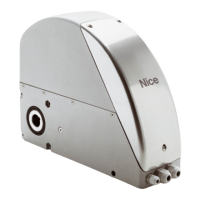2.3) Installing SUMO (standard procedure)*
1. Use a Philips screwdriver to unscrew the 3 screws of the
mobile cover and remove it (fig. 4).
2. Thread the wire through the cable holder (fig. 5).
3. Knock out the two aluminium plates and insert the two cable
holders (21) (fig. 6).
4a. Lower the release lever with one hand (5).
4b. Block the lever with the bolt (14). (fig. 7).
5 After identifying on which side the gear motor must be
installed, proceeding as indicated in the preliminary checks,
insert SUMO in the spring holder shaft so that the two grooves
coincide. Insert the tab (31) leaving it projecting from SUMO
sufficiently far for it to be blocked with the clamp (not supplied)
(fig. 8).
6 Rest the fixing bracket (41) against the wall and find the best
hole for keeping SUMO parallel with the wall. Fix the bracket to
SUMO with a screw (54) (fig. 9).
7 Drill holes in the wall over the holes of the bracket and fix it to
the wall (for this operation, read the following fixing tips)
8 Hold the release lever with one hand, open the bolt and move
it to the initial position.
* for the SU2010 version, please read chap. 3 “Installing the release
device”.
Fixing tips (fig. 9a)
Fixing to steel:
If the bracket must be fixed to a steel bar use an M8 6.8 or
M8 A2-50 bolt.
Fixing to concrete:
M8 HILTI HST-R-M8 expansion screw
h: 100mm (minimum wall thickness)
h1: 55mm (depth of hole)
Tinst: 25Nm (tightening torque)
hd: 9mm (depth of through hole)
Sw: 13mm (type of wrench)
If the wall is different from the above descriptions (masonry, wood,
plastic, etc.), the fitter must choose the most suitable fixing method
bearing in mind that the fixing system must withstand a traction force
of 1000N (100kg).
2.4) Installing Sumo with vertical chain
Installation for special applications.
This installation system is required if:
- during the preliminary checks it was found that the size of the gear
motor makes standard installation impossible
- during the preliminary checks it was found that the release
manoeuvre could not be performed safely and easily;
- the level of transmitted torque is required to be increased with a
further reduction. (Please consult the builder of the sectional door
to discover if it has been designed to withstand the required
torque).
NICE offers the following installation accessories:
CRA1 (shaft with pinion Z = 18)
CRA6 (gear Z = 36)
CRA7 (gear Z = 18)
CRA8 (wall-fixing bracket)
CRA2, CRA3, CRA4 (sufficient chain)
For a simple transmission of drive (Ratio 1:1) use: CRA1-CRA7
To reduce drive (Ratio 1:2) use: CRA1-CRA7
Please see fig. 10 for an example of installation.
- Keep the chain loose slack before fixing SUMO to the wall,
otherwise after fixing the cable may be too taut.
- After fixing the brackets to the wall, the slots allow the position of
SUMO to be adjusted in order to ensure the chain is fairly taut.
Tighten the screws to complete fixing.
- Make that the pinion and the gear remain at the same level
- The chain must be at least 2.4m from the ground and always
positioned so that it cannot be reached by people’s arms; if this is
not possible, protect it with a safety guard.
Make sure that the shaft to which the gear must be
splined is sufficiently rigid, that is, when subjected to a
load of 4000N (400kg) it does not bend more than 2mm.
Otherwise, suitably strengthen it
2.5) Installing Sumo with horizontal chain
Installation on two-leaf sliding doors
Fig. 11 shows an installation example for driving two sliding wing.
NICE offers the following installation accessories:
CRA1 (shaft with pinion Z = 18)
CRA5 (chain tightening device)
CRA8 (wall-fixing bracket)
CRA2, CRA3, CRA4 (sufficient chain)
Please refer to the previous paragraph for installation instructions.

